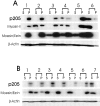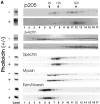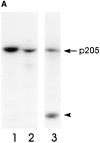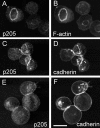Supervillin (p205): A novel membrane-associated, F-actin-binding protein in the villin/gelsolin superfamily
- PMID: 9382871
- PMCID: PMC2140202
- DOI: 10.1083/jcb.139.5.1255
Supervillin (p205): A novel membrane-associated, F-actin-binding protein in the villin/gelsolin superfamily
Abstract
Actin-binding membrane proteins are involved in both adhesive interactions and motile processes. We report here the purification and initial characterization of p205, a 205-kD protein from bovine neutrophil plasma membranes that binds to the sides of actin filaments in blot overlays. p205 is a tightly bound peripheral membrane protein that cosediments with endogenous actin in sucrose gradients and immunoprecipitates. Amino acid sequences were obtained from SDS-PAGE-purified p205 and used to generate antipeptide antibodies, immunolocalization data, and cDNA sequence information. The intracellular localization of p205 in MDBK cells is a function of cell density and adherence state. In subconfluent cells, p205 is found in punctate spots along the plasma membrane and in the cytoplasm and nucleus; in adherent cells, p205 concentrates with E-cadherin at sites of lateral cell-cell contact. Upon EGTA-mediated cell dissociation, p205 is internalized with E-cadherin and F-actin as a component of adherens junctions "rings." At later times, p205 is observed in cytoplasmic punctae. The high abundance of p205 in neutrophils and suspension-grown HeLa cells, which lack adherens junctions, further suggests that this protein may play multiple roles during cell growth, adhesion, and motility. Molecular cloning of p205 cDNA reveals a bipartite structure. The COOH terminus exhibits a striking similarity to villin and gelsolin, particularly in regions known to bind F-actin. The NH2 terminus is novel, but contains four potential nuclear targeting signals. Because p205 is now the largest known member of the villin/gelsolin superfamily, we propose the name, "supervillin." We suggest that supervillin may be involved in actin filament assembly at adherens junctions and that it may play additional roles in other cellular compartments.
Figures





















Similar articles
-
Domain analysis of supervillin, an F-actin bundling plasma membrane protein with functional nuclear localization signals.J Cell Sci. 1999 Jul;112 ( Pt 13):2125-36. doi: 10.1242/jcs.112.13.2125. J Cell Sci. 1999. PMID: 10362542
-
Afadin: A novel actin filament-binding protein with one PDZ domain localized at cadherin-based cell-to-cell adherens junction.J Cell Biol. 1997 Oct 20;139(2):517-28. doi: 10.1083/jcb.139.2.517. J Cell Biol. 1997. PMID: 9334353 Free PMC article.
-
Cloning, characterization, and chromosomal localization of human superillin (SVIL).Genomics. 1998 Sep 15;52(3):342-51. doi: 10.1006/geno.1998.5466. Genomics. 1998. PMID: 9867483
-
Gelsolin: the tail of a molecular gymnast.Cytoskeleton (Hoboken). 2013 Jul;70(7):360-84. doi: 10.1002/cm.21117. Epub 2013 Jun 27. Cytoskeleton (Hoboken). 2013. PMID: 23749648 Review.
-
Evolution of the gelsolin family of actin-binding proteins as novel transcriptional coactivators.Bioessays. 2005 Apr;27(4):388-96. doi: 10.1002/bies.20200. Bioessays. 2005. PMID: 15770676 Review.
Cited by
-
Autophagy induction in the skeletal myogenic differentiation of human tonsil-derived mesenchymal stem cells.Int J Mol Med. 2017 Apr;39(4):831-840. doi: 10.3892/ijmm.2017.2898. Epub 2017 Feb 20. Int J Mol Med. 2017. PMID: 28259927 Free PMC article.
-
Critical regulation of genes for tumor cell migration by AP-1.Clin Exp Metastasis. 2004;21(4):293-304. doi: 10.1023/b:clin.0000046132.46946.dd. Clin Exp Metastasis. 2004. PMID: 15554385
-
Duality of the SVIL expression in bladder cancer and its correlation with immune infiltration.Sci Rep. 2023 Sep 5;13(1):14595. doi: 10.1038/s41598-023-41759-1. Sci Rep. 2023. PMID: 37670039 Free PMC article.
-
The membrane-associated protein, supervillin, accelerates F-actin-dependent rapid integrin recycling and cell motility.Traffic. 2010 Jun;11(6):782-99. doi: 10.1111/j.1600-0854.2010.01062.x. Epub 2010 Mar 17. Traffic. 2010. PMID: 20331534 Free PMC article.
-
Roles of testosterone in the growth of keratinocytes through bald frontal dermal papilla cells.Endocrine. 1999 Dec;11(3):321-7. doi: 10.1385/ENDO:11:3:321. Endocrine. 1999. PMID: 10786829
References
-
- Aberle H, Schwartz H, Kemler R. Cadherin-catenin complex: protein interactions and their implications for cadherin function. J Cell Biochem. 1996;61:514–523. - PubMed
-
- Altschul SF, Gish W, Miller W, Myers EW, Lipman DJ. Basic local alignment search tool. J Mol Biol. 1990;215:403–410. - PubMed
-
- Anderson JM, Van Itallie CM. Tight junctions and the molecular basis for regulation of paracellular permeability. Amer J Physiol. 1995;269:467–475. - PubMed
-
- Atkinson PH. HeLa cell plasma membranes. Methods Cell Biol. 1973;7:157–188. - PubMed
-
- Ausubel, F.M., R. Brent, R.E. Kingston, D.D. Moore, J.G. Seidman, J.A. Smith, and K. Struhl. 1989. Current Protocols in Molecular Biology. Vol. 1. John Wiley & Sons, New York.
Publication types
MeSH terms
Substances
Associated data
- Actions
- Actions
- Actions
Grants and funding
LinkOut - more resources
Full Text Sources
Other Literature Sources
Molecular Biology Databases
Research Materials

